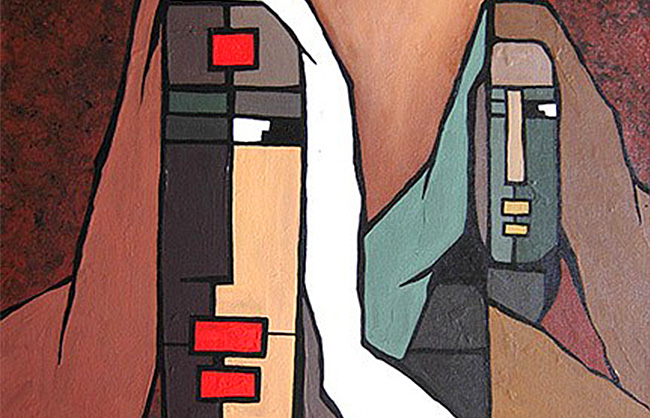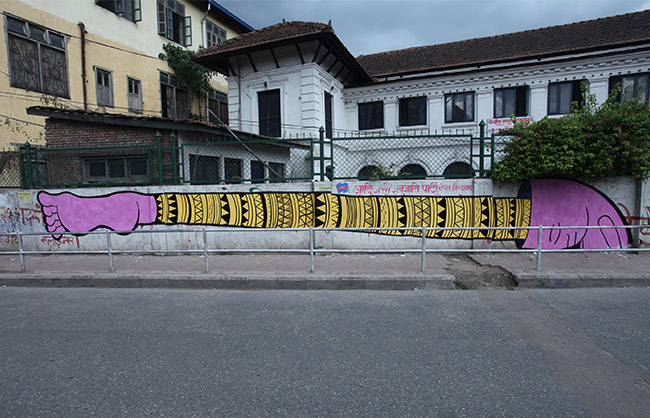Writing
Project Details
Title: Evincing emotions
Category: Writing
Date: 24 November 2015
Share:
Visiting exhibitions of young Nepali Modern Impressionists in the city is always a rare pleasure, but now and again, a show comes along more sumptuous than the rest, in which not only the quality of the works presented, but the fresh temptation they brace, makes them exceptional. Such is the case with ‘Abyakta Abhibyaktiharu’, (Unexpressed Expressions), an exhibit of paintings by Sangee Shrestha, going on at Siddhartha Art Gallery, Babar Mahal Revisited from March 31. Blended along the ideologies of cubism, not only is each painting spectacular, but the entire exhibition too is brilliantly conceived by Sangeeta Thapa, art curator at Revisited.
Painter, art teacher and cartoonist Sangee Shrestha began fiddling with the idea of this exhibition about seven years ago, though the idea was not new to her. In 2002, a collaborative exhibition of Sangee Shrestha and Judith Hecker, a German artist was held at the Art Council, Babar Mahal. Back then, Sangee’s canvasses used painted mediums to display familiar sights of Gokarna, Trishuls and flames blowing out of Diya that were subjective paintings people could easily relate to. This time, she arrays semi-modern canvasses that tell the story of women in Nepal, but what remains the same is the fiery subdued tones and the promise of enchantment for the viewers.
“Sangee is amongst the most promising artists of this period,” Radhe Shyam Mulmi, a senior artist and associate professor at Lalitkala Fine Arts Campus, TU, said. “Her works are the manifestation of modern painting. What the exhibit shows is constant dialogue between the time lapses she had foreseen. She has demonstrated outstanding sense of colour balance and composition, which in itself is a rare treat.â€
The 39 acrylic on canvas paintings illustrate her continual stylistic and thematic exchanges. She is confident with colour, form, geometric balance and agrees that these works revolve around the lives of Nepali women. She has started a new trend in Nepali art and yet has managed to fashion her own style. While the recurring square form in her works bring colourful contrast, they also maintain a harmony between feminine faces.
The artist spent over five years working out the idea of the exhibition, which projects images of time lapses with geometric figures painted against rough textures. Said curator Sangeeta Thapa: “Some women may find comfort in boundaries allotted to them. Not Sangee. Her paintings are a rejection of boundaries imposed upon women and of the hypocrisy that perpetuates a woman’s ‘place’ in society. The artist finds the hypocrisy stifling.â€
Apart from the palette of colours Sangee uses, the other fact that stands out while one moves from one piece of her work to another is that the paintings are unnamed. When queried, Sangee humbly said: “An artist is an isolated performer and artistic talent cannot be extracted from books. It cannot be confined within limits and cannot be named. You cannot describe artistic freedom in words, as words are never enough to mirror your thoughts. It is due to this fact that I have not been able to give my works titles.†The paintings are in fact so powerful that the artist is comfortable to let them speak for themselves. Each work leads the visitor to the next with no commentary, and yet no painting seems out of place.
Consequently, as one steps into the exhibition, one confronts paintings ranging from 36 x 51 inches to 12 x 12 inches playing along various aspects of feminism. Some are beautifully hung in twos and threes, conveying a single image to the viewer. The affluent blue, orange, bright yellow and solid red textures stand vividly against the wall. Some colours dramatically jut out of the paintings in form of bold lines. The subdued tones she uses come out of her experienced palette.
Firm black lines run along the geometrical bright hues forming boundaries. These lines speak of human emotions confined within virtual limit. The prominent verse of red and black symbolise power and suppression. Glides of time and emotions have been conveyed in form of stairs where each step is a painted face hung within her canvasses. Metal embosses, rough jute patches painted in gold, turbulent wild layers of textures underneath the colours and threads glued carelessly portray the enigma of human existence. The perfection with which the artist strokes her emotions speak of her long history in installation art. Amidst the violent contrasts, some pieces are almost primitive, only adding vibrancy to the diverse display.
The exhibition is framed on time lapses. Most of the bright and golden tones are hung in the first floor of the gallery. A particular piece drawn completely with golden shades at the entrance subjects the viewer to a torrent of political sarcasm. Few pieces are experimental, a blend of impressionism and the traditional Mithila art. Moving on to the second floor, the paintings hint of a nice balancing act. Shafts of light that enter from the roof fall on bright artworks. Progressing, the visitor finds himself standing against gray tones; faces with lips open and white clothes on. These trigger the memories of the tragedy the nation once witnessed. The journey through the flawless paintings is eternal, just as the emotions unexpressed.
Those antique faces with their lips open, red square blocks for Tika, blocks of distinguished colours for confusion, boundaries of black suppressing emotions are sure to make an impact on future art scene.
Though most paintings look the same, they are very different. Studied up close, it becomes obvious that Sangee has a different language. When certain works with similar subject matter and colours and postures are put together, no further explanation is necessary.
Said Sangee: “Every loss cuts across the soul. Happiness also transforms our expressions. No human can hide his impulses. People strive in vain to confine their feelings, to restrict these emotions from bursting out into the open. But it is just the matter of time; the truth unfolds sooner or later and it all appears on the face. An avid eye can read these details. I have tried to express those very sentiments through colours. These are just ordinary events around us.”
Abyakta Abhibyaktiharu continues at Siddhartha Art Gallery at Babarmahal Revisited till April 20.
Printed on: 2009-04-06| APR 06








